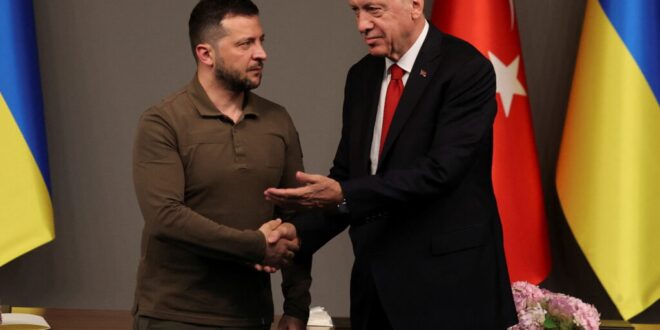The burgeoning defense partnership between Ukraine and Turkey has helped Kyiv in its fight to fend off Russia and shored up Ankara’s security while bolstering the two partners’ economies. But now, there’s an opportunity to expand that partnership—and in so doing, secure the Black Sea and Europe at large.
The benefits of that partnership have been made clearer over the past two years, with Bayraktar TB2 drones—manufactured by Turkish defense company Baykar—grabbing headlines for helping Ukraine by bolstering Kyiv’s air-strike capabilities in the beginning of Russia’s full-scale invasion.
Just weeks before Russian President Vladimir Putin launched the war, Turkish President Recep Tayyip Erdoğan—during a visit to Kyiv—struck a deal with Ukrainian President Volodymyr Zelenskyy to allow Ukrainian factories to produce Turkish drones. That deal is now bearing fruit, with Baykar breaking ground on a drone factory near Kyiv in February. The factory, which will take twelve months to build, is expected to create five hundred jobs and produce 120 units a year. NATO Secretary General Jens Stoltenberg pointed to the project, calling it an example of how NATO allies are supporting Ukraine not only “with direct deliveries of weapons and ammunition but also by investing in and ramping up their capacity to produce their own weapons.”
Turkey and Ukraine’s strategic partnership stretches further. For example, Baykar’s Akıncı combat drone (introduced in 2021) and its Kızılelma combat drone (expected to be introduced this year) use Ukrainian-made Ivchenko-Progress engines. The Kızılelma has even been called a “Turkish bird with a Ukrainian heart.” Kyiv and Ankara also cooperate in the maritime domain; since 2021, Turkey has been building two Ada-class anti-submarine corvettes for Ukraine’s naval forces, expected to be completed and delivered this year. The Ukrainian Armed Forces received Cobra II tactical vehicles—developed by Turkish company Otokar—and were seen deploying them last year. Also in 2023: Ukraine sent two engines to the Turkish Aerospace Industries (TAI) for the company’s T929 ATAK-II attack helicopter; Ukraine has committed to send twelve more by 2025.
While the flow of Turkish defense equipment northward to Ukraine has been strong, it has experienced headwinds. For example, European countries have been unable to come to a consensus on topping up the European Peace Facility, the mechanism with which the European Union (EU) funds weapons supplies for Ukraine. France, Greece, and Cyprus have blocked additional financing out of a desire to ensure that funds are spent on weapons, technologies, and ammunition from the EU. Greece said that it did not want the money to go to Turkish defense companies. The countries should let up on this demand—France recently has, for the procurement of artillery. Supplying Ukraine is not just about Kyiv’s security; it is also about Black Sea security and Euro-Atlantic security.
Nevertheless, the Ukraine-Turkey bilateral defense partnership has room to expand. On February 21, TAI announced that its KAAN fighter jet conducted its first flight. The jet was conceptualized and developed initially to replace the Turkish Air Force’s aging F-16 fleet and to bolster Turkey’s self-sufficiency—before the United States decided to sell Turkey forty new F-16s and equipment to upgrade dozens more. While the KAAN jet prototype is currently powered by General Electric F-110 engines (the engine that powers F-16s), Turkey is aiming to start using domestically produced engines produced by TAI Engine Industries by 2028. However, there may be a role for Ukraine in the project, as Ukrainian Ambassador to Turkey Vasyl Bodnar recently stated that not only is Ukraine looking to buy and use the KAAN jet, but “Ukrainian teams continue to work on the engine” and are “competing” to be a partner on the project.
A Ukraine-Turkey partnership on joint engine production for the KAAN jet would contribute to Ukraine’s economy and also provide Turkey a trustworthy and steady partner in bolstering its self-defense—political divides between Ankara and the West could potentially erupt into measures such as export license bans as was the case in 2019 with some European Union governments’ limiting arms exports following Turkey’s operation in northeast Syria and in 2020 with the United States imposing sanctions on Turkey following Ankara’s purchase of Russia’s S-400 missile defense system.
NATO countries have acknowledged the important role that fighter jets play in the region’s security. Ukraine has been offered sixty second-hand F-16 fighter jets by the Netherlands, Denmark, and Norway. Last year, Denmark, the United States, and the United Kingdom began training Ukrainian pilots. In November last year, Romania received three of the thirty-two F-16s it bought from Norway. By 2025, Romania is expected to own forty-nine F-16s. Bulgaria is also gearing up to receive the sixteen F-16 Block 70 fighter jets it bought from the United States; the first eight are expected to arrive by 2025.
Turkey plans to export some KAAN jets, which could offer countries an alternative to fighter aircraft manufactured and sold by Russia and China. And, once Turkey has more KAAN jets off the ground and more F-16 upgraded in its fleet, it could support Ukraine with second-hand F-16s or by serving as a repair and upgrade hub for the F-16s that Ukraine and other Black Sea countries own.
Benefits that ripple across the sea
An expanded Ukraine-Turkey security partnership would compound upon the beneficial effects of previous efforts to secure the region undertaken by NATO countries.
In both its 2022 Strategic Concept and its 2023 Vilnius Summit communiqué, NATO called Russia “the most significant and direct threat to Allies’ security and to peace and stability in the Euro-Atlantic area.” In both documents, the Alliance also reiterated the “strategic importance” of the Black Sea. The United States—the NATO member with the largest military—echoed this in its 2024 National Defense Authorization Act, where it emphasized the need to bolster defenses in the region and increase cooperation on Black Sea security, not only bilaterally with regional partners—specifically Ukraine, Romania, Bulgaria, Moldova, and Georgia—but also with NATO and the EU to minimize the risk of duplicating efforts and to improve interoperability.
Strengthening NATO’s deterrence and defense in the Black Sea region is even more important as the US presidential election looms. Former US President Donald Trump, a candidate again this year, has repeatedly argued that the United States is unfairly carrying the burden of financing NATO. Recently, he added that he would encourage Russia to do whatever it wants to any NATO country that doesn’t meet the Alliance’s defense spending guidelines. This kind of announcement unfortunately encourages an imperialist president such as Putin.
Since Russia’s full-scale invasion of Ukraine began and threats to the Black Sea region increased, NATO and its members have worked to bolster the region’s defense and deterrence capabilities. NATO increased its forward presence in the region by establishing four new battlegroups in Bulgaria, Hungary, Romania, and Slovakia. The United States has developed close security cooperation with Romania and Bulgaria, providing them with important defense technology and weapons as well as Foreign Military Financing to support their military modernization efforts and regional defense capabilities. The United States is also leading a Black Sea Maritime Domain Awareness project, in which Bulgaria, Romania, Ukraine, and Georgia are participants.
Ukraine has disabled one-third of the Russian Black Sea Fleet. With Turkey being the guardian of the straits under the Montreux Convention, Russia will not easily be able to replace these losses. NATO allies should take advantage of the opportunity they now have to get the upper hand in the maritime domain against Russia. Montreux limits the passage of non-Black Sea countries’ naval forces through the straits and the amount of time these forces can spend in the Black Sea; but the United States and non-littoral European countries, seeking to bolster Black Sea allies’ defense capabilities, can lean more on Turkey. The erosion of Russia’s capabilities has shifted the balance of power in the Black Sea to Turkey’s advantage. Turkey could lead naval operations in the international waters in the Black Sea, further out from its coastline, with its TCG Anadolu assault ship without a NATO mandate. While there is no specific mention of Turkey in the US Black Sea strategy, the outline for which is reflected in the US National Defense Authorization Act for Fiscal Year 2024, the existing structure of the law is enough for the US to support—alone or in cooperation with other NATO allies—the Black Sea countries with additional capabilities and efforts to improve interoperability.
A Ukraine-Turkey partnership on the KAAN jet would add to these efforts and bolster security in the region.
What’s at stake
Gridlock in the US Congress over approving additional financial support to Ukraine and debate over whether the war is at a stalemate—in addition to Ukraine’s losses on the battleground and its ammunition shortage—have alarmed many European capitals.
After weeks of resistance from Hungary, the EU agreed to $54 billion in long-term aid to Ukraine. European countries, for their part, are also pitching in to shore up Ukraine’s and the Euro-Atlantic community’s security. Germany, which ranks second in military assistance committed to Ukraine, is—among other initiatives—building a new ammunition factory in response to Germany’s and Europe’s needs. German Chancellor Olaf Scholz also called on Europe to “move… towards large-scale production of defense equipment.” Good news also came out of Denmark, as the prime minister announced that she would pledge all of the country’s artillery arsenal to Ukraine. France has also recently concluded a security pact with Ukraine, pledging up to three billion euros in military aid—including cooperation on artillery—and the Netherlands has committed to providing 2.2 billion euros in military aid this year.
Turkey has also looked to boost Euro-Atlantic security. Turkey and the United States are already cooperating to replenish the United States’ munitions stockpiles, critical considering Washington’s role in supplying ammunition to Ukraine. According to the US ambassador to Turkey, by next year, 30 percent of all 155 mm rounds made in the United States will be manufactured by factories that are part of a partnership between the US Department of Defense and a Turkish defense company. Turkey, as well as Greece, recently joined the German-led European Sky Shield Initiative, which offers participating countries a platform through which they can jointly procure air defense capabilities, an important contribution to European security. All these efforts and initiatives are important, as the United States, NATO, and EU will need to prepare over the next eleven months for a potential Trump presidency.
Leaders in the West are putting into words how important it is for Ukraine to win. As French President Emmanuel Macron said, Russian defeat in Ukraine is vital for security in Europe; Scholz stressed that what happens in Ukraine will decide “if our [peaceful] order, our rules-based world has a future.” Ukraine’s defense-industrial know-how and Turkey’s experience in manufacturing combine into a win-win security partnership that can pay dividends for Black Sea security, Euro-Atlantic security, and—ultimately—the international rules-based order.
 Eurasia Press & News
Eurasia Press & News



